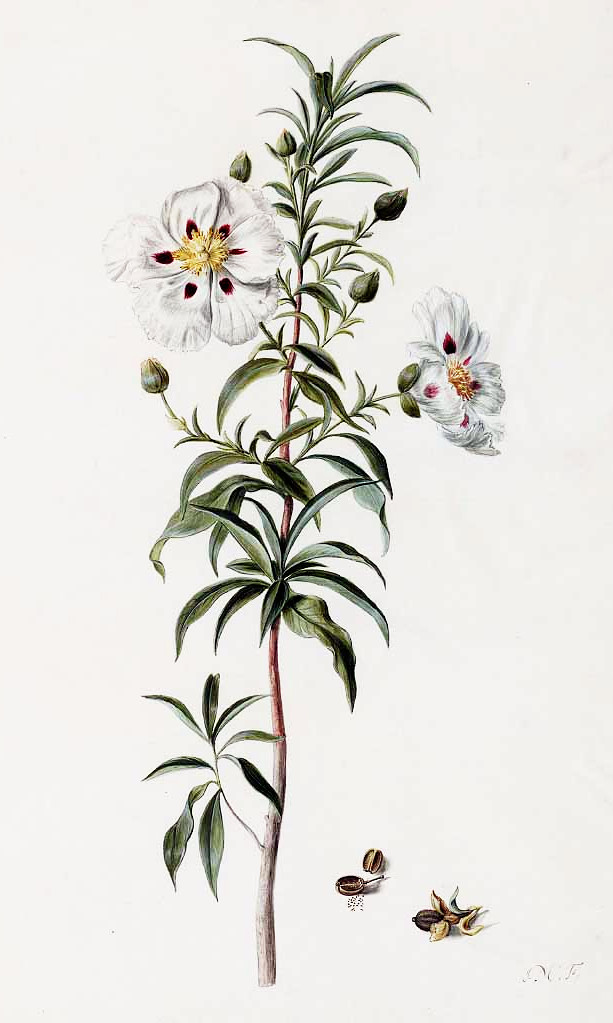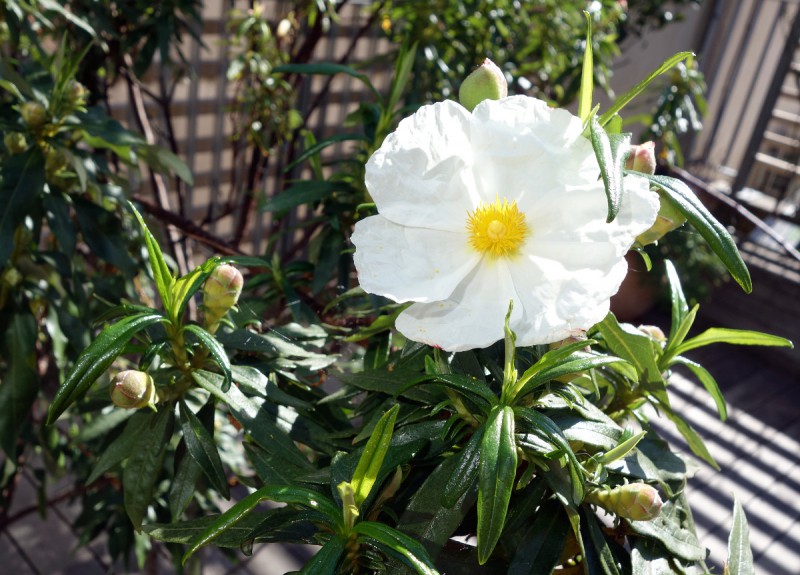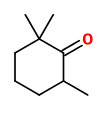Dies ist eine alte Version des Dokuments!
Cistus ladanifer L. - Cistaceae - common gum cistus, gum rockrose, Lack-Zistrose
Native fragrant shrub of the Mediterraneaen and North Africa; cultivated in France, Spain and Madagascar.
„Evergreen shrub of loose, open habit with very sticky, narrow, aromatic leaves, dark green above, grey beneath. Flowers to 10cm in width, white with a deep red blotch at the base of each petal“ http://www.rhs.org.uk/plants/details?plantid=2453
„It is a popular ornamental plant, grown for its strongly resin-scented foliage and conspicuous flowers. Its leaves yield a fragrant oleoresin known as labdanum, used in perfumes, especially as a fixative.“
http://en.wikipedia.org/wiki/Cistus_ladanifer
Labdanum resin is the sticky exudate of the glandular hairs of C.labdaniferum. Maceration with alcohol yield 1-2% of labdanum oil.
Cistus oil is the essential oil produced by solvent extraction or steam distillation of the twigs with leaves.
Among the volatile components of Cistus ladanifer leaves, the norisoprenoid 2,6,6-trimethylcyclohex-2-enone was identified as the main compound responsible for the leaf odor.
[Volatile components of Cistus ladanifer leaves. Ramalho, Paula S., et al., Flavour and fragrance journal Vol.14 (5), 1999, 300-302]
The most common compounds found in cistus essential oil are: α-pinene (0-56%), camphene (0-10%), limonene (0-2%), p-cymene (0-4%), 2,2,6-trimethylcyclohexanone (0-11%), α-campholenic aldehyde (0-3%), bornyl acetate (2-3%), terpinen-4-ol (0-3%), allo-aromadendrene (0-1%), trans-pinocarveol (0-7%), borneol (0-3%), myrtenol (0-2%), ledol (0-13%), viridiflorol (0-21%). The odor intensive ambrox is present at 0.8%.
[Characterization of the Portuguese-grown Cistus ladanifer essential oil. Gomes, Paula B., Vera G. Mata, and A. E. Rodrigues. Journal of Essential Oil Research, Vol.17 (2), 2005, 160-165] http://teresacasimiro.com.sapo.pt/Bibliographic_References/21.pdf
[Simultaneous distillation–extraction of high-value volatile compounds from Cistus ladanifer L., Teixeira, Salomé, et al., Analytica chimica acta 584.2, 2007, 439-446]
http://repositorio-aberto.up.pt/bitstream/10216/67702/2/12532.pdf
„Labdanum oil is a mixture of ca. 250 compounds… Only ten compounds, i.e., (-)α-pinene, (+)-camphene, pinocarveol, bornyl acetate, borneol, 2,2,6-trimethylcyclohexanone, (Z)-ocimenone, (-)-allo-aromadendrene/(+)-ledene, (+)-ledol, and viridiflorol, occur in concentrations above 1%, however, these do not represent the complex odor profile of the oil. The odor character of labdanum oil is on the contrary determined by a large number of oxygenated trace compounds such as (-)-ambrox, 6-oxoisoambrox and a decahydronaphthalenol, which are responsible for the distinct ambery character… The smoky-leathery notes and the animalic undertones are caused by a complex of 25 phenols (1.5%)… The character-impact compound of oakmoss, methyl beta-orcinolcarboxylate, is responsible for the powdery, moss-like undertones… Another constituent, 2-methyloctanoic acid, has a strong labdanoic odor on its own, (and) 3,4,4-trimethylcyclopentane-1,2-dione… has a strong celery aroma.“
[S.Escher, Firmenich SA, unpublished results; cited by Roman Kaiser, Meaningful Scents around the World, Roman Kaiser, Zürich 2006, 313ff]

Moninckx,J., Moninckx atlas, vol.2, t.41 (1682-1709)
http://plantgenera.org/species.php?id_species=248956

Cistus ladanifer, CC BY-SA 3.0, Author: Andreas Kraska

